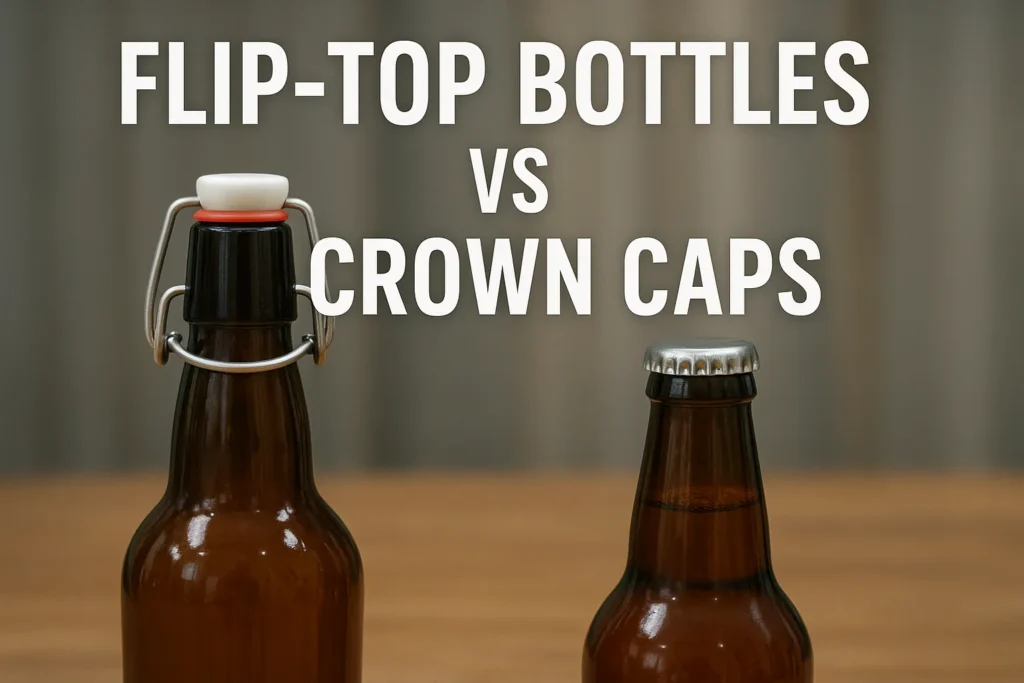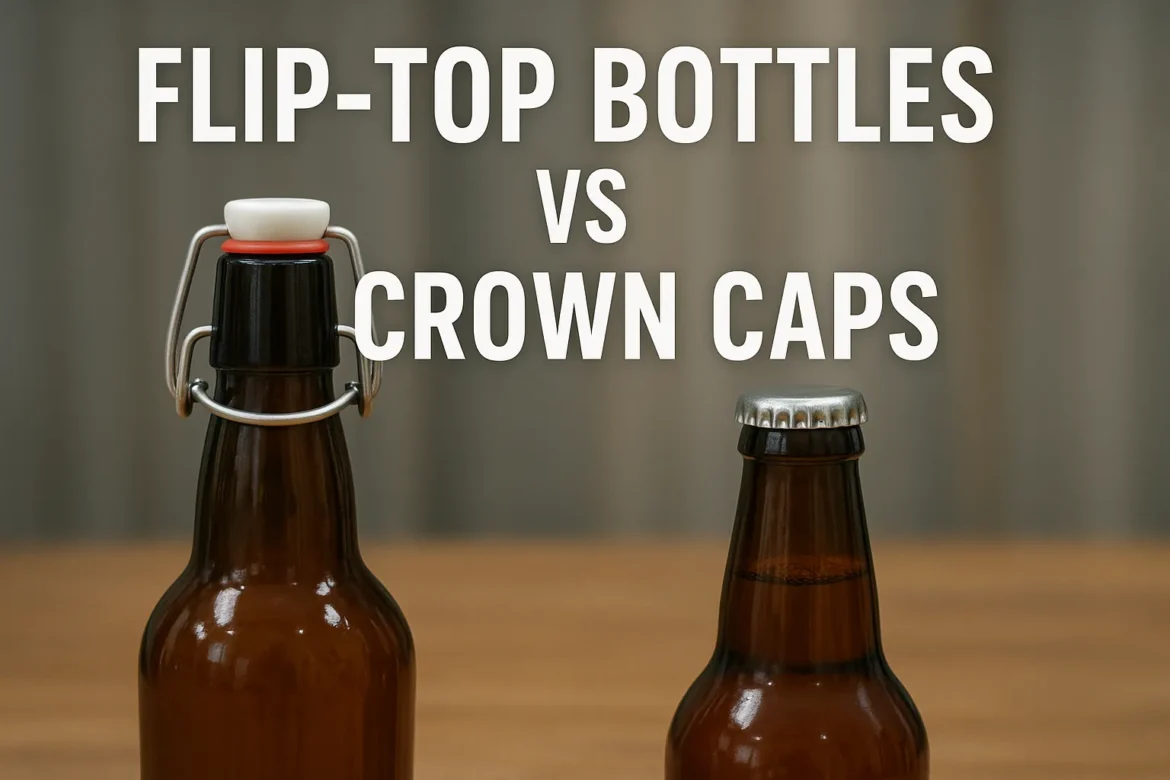Compare flip-top bottles vs crown caps for homebrewing with our comprehensive analysis. Discover advantages, disadvantages, costs, sealing effectiveness, and expert recommendations to choose the perfect bottle closure system for your beer packaging needs.

The choice between flip-top bottles and crown caps represents one of the most fundamental decisions every homebrewer faces, affecting everything from bottling efficiency to long-term beer quality. After fifteen years of brewing and bottling thousands of batches using both closure systems extensively, I can confidently state that this decision impacts not just operational convenience, but storage longevity, carbonation retention, and even the perceived quality of your finished beer.
My brewing journey began with traditional crown cap bottles, laboriously crimping each closure while building impressive biceps from countless capping sessions. The revelation came when I discovered flip-top bottles during a German brewery visit—suddenly, bottling transformed from tedious chore to efficient process, though not without introducing new considerations about cost, availability, and long-term performance.
This comprehensive comparison examines every aspect of flip-top bottles versus crown caps, analyzing performance across different brewing scenarios, storage conditions, and operational requirements. Through systematic testing, real-world brewing experience, and detailed analysis of sealing effectiveness, carbonation retention, and practical considerations, this guide provides insights needed to make informed bottle closure decisions.
Whether you’re starting your brewing journey or reconsidering existing bottling practices, understanding the fundamental differences between these closure systems ensures your choice aligns with brewing goals, budget constraints, and quality expectations that make every bottle worthy of your brewing efforts.
Understanding Bottle Closure Technology and Sealing Principles
Both flip-top bottles and crown caps achieve beverage sealing through fundamentally different mechanisms that affect performance, longevity, and operational characteristics. Understanding these principles guides intelligent selection based on specific brewing requirements.
Crown Cap Sealing Mechanics
Crown caps create seals through mechanical crimping that compresses a polymer liner against the bottle finish, forming an airtight barrier. The metal cap distributes pressure evenly around the bottle neck while the liner material provides the actual sealing interface that prevents gas exchange.
Flip-Top Closure Systems
Flip-top bottles employ rubber or silicone gaskets compressed between porcelain stoppers and glass bottle openings. The wire bail mechanism provides consistent pressure that maintains gasket compression while enabling repeated opening and closing without degradation.
Pressure Resistance and Carbonation Handling
Both systems handle typical beer carbonation levels effectively, though their pressure resistance characteristics differ. Crown caps distribute stress across the entire cap surface, while flip-top systems concentrate pressure on gasket contact areas, creating different failure modes and longevity patterns.
Gas Permeability and Long-Term Storage
Oxygen ingress rates vary between closure types due to different sealing materials and mechanisms. Understanding these permeability differences helps predict long-term storage performance and optimal applications for each closure system.
Reusability and Lifecycle Considerations
Crown caps represent single-use closures requiring replacement after opening, while flip-top systems enable hundreds of opening cycles with proper maintenance. This fundamental difference affects both operational costs and environmental impact over extended periods.
Flip-Top Bottle Analysis: Advantages and Performance
Flip-top bottles offer unique advantages that make them attractive for specific brewing applications, though understanding their limitations ensures appropriate selection and optimal performance.
Operational Efficiency and Bottling Speed
The convenience of flip-top bottles becomes apparent during bottling sessions where single-handed closure operation significantly reduces cycle time per bottle. Experienced brewers report 30-50% faster bottling speeds using flip-tops compared to crown cap operations requiring separate capping tools.
Reusability and Environmental Benefits
Flip-top bottles enable hundreds of reuse cycles with proper care and maintenance, creating significant environmental advantages through reduced waste generation. The elimination of disposable caps appeals to environmentally conscious brewers while providing long-term cost benefits.
Professional Appearance and Presentation
The distinctive appearance of flip-top bottles creates premium presentation that enhances perceived beer quality. The traditional European styling suggests craft attention and quality that can elevate homebrew perception among recipients and tasters.
Ease of Opening and Consumer Convenience
Flip-top mechanisms enable easy opening without tools or bottle openers, providing convenience that encourages consumption and sharing. The smooth opening action prevents the abrupt pressure release that can disturb sediment in bottle-conditioned beers.
Pressure Release Control and Sediment Management
Unlike crown caps that pop off suddenly, flip-top mechanisms enable gradual pressure release that minimizes sediment disturbance in bottle-conditioned beers. This controlled opening preserves beer clarity while preventing excessive foaming during service.
Limitations and Operational Challenges
Flip-top bottles require more careful handling and storage to prevent gasket damage or wire mechanism failure. The complex closure system includes more failure points compared to simple crown cap installations, potentially affecting long-term reliability.
| Flip-Top Advantages | Impact Level | User Experience | Cost Consideration |
|---|---|---|---|
| Bottling Speed | High | 30-50% faster | Labor savings |
| Reusability | High | Hundreds of cycles | Long-term savings |
| Appearance | Moderate | Premium presentation | Marketing value |
| Opening Convenience | High | No tools required | User satisfaction |
| Pressure Control | Moderate | Gradual release | Quality preservation |
Crown Cap System Evaluation: Reliability and Cost-Effectiveness
Crown caps represent the traditional standard for beer packaging, offering proven reliability and cost-effectiveness that makes them the preferred choice for most commercial and homebrewing applications.
Universal Availability and Standardization
Crown caps benefit from universal standardization and worldwide availability, ensuring consistent supply and competitive pricing. The ubiquity of crown cap bottles from commercial beer consumption provides readily available packaging material for homebrewers.
Cost Analysis and Economic Advantages
The low per-unit cost of crown caps (typically $0.02-0.05 each) creates significant economic advantages for large-volume bottling operations. Initial investment in capping equipment pays returns quickly through reduced per-bottle packaging costs.
Sealing Performance and Long-Term Reliability
Crown caps provide excellent sealing performance with minimal maintenance requirements. The simple mechanical crimping system creates reliable seals that maintain integrity throughout typical storage periods without adjustment or replacement.
Bottle Compatibility and Flexibility
Crown caps work with virtually any standard beer bottle, providing maximum flexibility for recycling commercial bottles or purchasing new packaging. This compatibility eliminates concerns about finding specific bottle types or replacement parts.
Professional Industry Standards
The brewing industry’s reliance on crown caps demonstrates their proven performance in demanding commercial applications. Understanding professional practices guides homebrewing equipment selection and quality expectations.
Operational Considerations and Tool Requirements
Crown cap installation requires capping tools that add complexity and cost to bottling operations. Quality handheld cappers cost $15-40, while bench cappers range $50-150, representing necessary investments for crown cap operations.
Comparative Analysis: Sealing Effectiveness and Carbonation Retention
Understanding how different closure systems perform under various conditions guides selection based on specific storage requirements, carbonation levels, and quality expectations.
Carbonation Retention Testing
Systematic testing reveals minimal differences in carbonation retention between properly sealed flip-top bottles and crown caps over typical storage periods. Both systems maintain adequate carbonation for most beer styles when properly applied and maintained.
Oxygen Ingress and Beer Stability
Long-term storage studies show similar oxygen ingress rates between quality flip-top gaskets and crown cap liners, though individual component quality significantly affects performance. Premium gaskets and caps outperform budget alternatives regardless of closure type.
Temperature and Humidity Effects
Environmental conditions affect both closure systems, with extreme temperatures potentially degrading gasket materials in flip-tops while humidity can cause crown cap liner deterioration. Understanding these effects guides storage optimization and system selection.
Pressure Cycling and Mechanical Stress
Repeated pressure cycling during storage affects closure integrity differently. Crown caps show consistent performance throughout their lifecycle, while flip-top gaskets may require periodic replacement or adjustment to maintain optimal sealing.
Quality Control and Consistency
Crown caps provide more consistent sealing performance due to standardized manufacturing and application procedures. Flip-top systems depend more on individual bottle and gasket quality, creating potential performance variations.
For comprehensive bottle closure optimization and advanced packaging techniques, explore the detailed resources at BrewMyBeer’s bottling guides, where professional packaging practices meet practical homebrewing applications.
Flip-Top Bottles vs Crown Caps Cost Analysis and Long-Term Economics
Understanding the complete cost picture for different closure systems includes initial investments, ongoing operational costs, and long-term value considerations that vary significantly with usage patterns.
Initial Investment Comparison
Crown cap systems require bottle acquisition ($0.50-2.00 each), caps ($0.02-0.05 each), and capping equipment ($15-150). Flip-top bottles cost $1.50-4.00 each initially but eliminate ongoing cap purchases and reduce equipment requirements.
Per-Bottle Cost Analysis
Crown caps maintain consistent per-bottle costs throughout their use, while flip-top bottles amortize initial costs over multiple uses. Break-even points typically occur between 30-100 uses depending on bottle and cap quality levels.
Equipment and Infrastructure Costs
Crown cap operations require capping tools and cap storage, while flip-top systems need gasket replacement supplies and careful handling procedures. Total infrastructure costs favor flip-tops for lower-volume operations and crown caps for high-volume applications.
Labor and Time Considerations
Bottling labor costs vary significantly between systems, with flip-tops providing 30-50% time savings that translate to meaningful labor cost reductions for frequent brewers. These savings accumulate over multiple bottling sessions.
Replacement and Maintenance Expenses
Crown caps eliminate maintenance costs through single-use design, while flip-top systems require periodic gasket replacement and mechanism maintenance. Understanding these ongoing costs guides long-term budget planning.
Practical Considerations: Storage, Handling, and Maintenance
Real-world performance depends on proper handling, storage, and maintenance procedures that vary significantly between closure systems and affect long-term success.
Storage Requirements and Space Efficiency
Flip-top bottles require more careful storage to prevent wire mechanism damage and gasket deformation. Crown cap bottles stack efficiently and resist handling damage, though caps require dry storage to prevent corrosion.
Cleaning and Sanitization Procedures
Both systems require systematic cleaning, though flip-top bottles present additional challenges including gasket removal, wire mechanism cleaning, and porcelain stopper sanitization. Crown cap bottles enable standard cleaning procedures with cap replacement before each use.
Gasket Replacement and Maintenance
Flip-top bottle gaskets require periodic replacement to maintain sealing integrity, typically every 50-200 uses depending on gasket quality and handling care. Replacement gaskets cost $0.50-2.00 each, affecting long-term operational costs.
Wire Mechanism Care and Adjustment
The hinged wire mechanisms require occasional adjustment and maintenance to ensure proper gasket compression. Understanding adjustment procedures prevents sealing failures while extending mechanism life.
Quality Control and Inspection
Systematic inspection procedures identify degraded gaskets, damaged wire mechanisms, or compromised bottle integrity before they cause sealing failures. Developing inspection routines maintains system reliability.
Environmental Impact and Sustainability Considerations
Environmental consciousness increasingly influences packaging decisions, with different closure systems presenting distinct sustainability profiles and environmental impacts.
Waste Generation and Disposal
Crown caps generate ongoing waste through single-use design, while flip-top bottles minimize waste through reusability. The environmental impact depends on usage patterns and end-of-life disposal methods.
Manufacturing Energy and Resource Consumption
Flip-top bottles require more complex manufacturing processes and materials, creating higher embodied energy compared to simple crown cap bottles. However, extended reuse cycles often offset these initial impacts.
Recycling and End-of-Life Considerations
Both systems offer recycling opportunities, though flip-top bottles provide direct reuse possibilities that exceed recycling benefits. Understanding local recycling capabilities guides environmental impact assessment.
Transportation and Distribution Effects
Flip-top bottles weigh more than crown cap alternatives, increasing transportation energy requirements. The trade-off between reusability benefits and transportation costs varies with distribution patterns.
Application-Specific Recommendations
Different brewing scenarios favor specific closure systems based on production volumes, storage requirements, distribution methods, and quality objectives.
Small-Batch Homebrewing
Homebrewers producing 5-10 gallon batches monthly may find flip-top bottles provide optimal convenience and cost-effectiveness through reduced bottling time and elimination of cap purchases. The premium appearance enhances gift and sharing applications.
High-Volume Homebrewing Operations
Brewers producing large volumes or multiple batches weekly often benefit from crown cap systems through lower per-bottle costs and simplified inventory management. The proven reliability supports high-throughput operations.
Gift and Special Occasion Brewing
Flip-top bottles excel for gift applications where presentation quality and opening convenience enhance recipient experience. The premium appearance and reusable nature create lasting value beyond the initial beer consumption.
Long-Term Aging and Storage
Extended aging applications may favor crown caps through proven long-term reliability and elimination of gasket degradation concerns. The simple sealing mechanism provides consistent performance over years of storage.
Commercial and Semi-Commercial Operations
Scaling toward commercial production typically necessitates crown cap systems through cost advantages, equipment availability, and industry standard practices that support business operations.
| Application Type | Recommended System | Key Advantages | Primary Considerations |
|---|---|---|---|
| Casual Homebrewing | Flip-Top | Speed, convenience | Initial cost |
| High-Volume Brewing | Crown Cap | Cost-effectiveness | Equipment investment |
| Gift Applications | Flip-Top | Presentation quality | Handling care |
| Long-Term Aging | Crown Cap | Proven reliability | Storage consistency |
| Commercial Scale | Crown Cap | Industry standards | Operational efficiency |
Quality Control and Performance Monitoring
Maintaining optimal performance from either closure system requires systematic quality control procedures and performance monitoring that identifies issues before they affect beer quality.
Sealing Performance Testing
Regular testing using carbonated water or test beverages identifies sealing problems before they affect valuable beer batches. Systematic testing protocols guide quality control procedures and replacement schedules.
Carbonation Level Monitoring
Tracking carbonation retention over time reveals closure system performance and identifies degradation patterns. This monitoring guides maintenance schedules and system optimization procedures.
Contamination Prevention Protocols
Both systems require contamination prevention through proper sanitization and handling procedures. Understanding system-specific contamination risks guides protocol development and quality assurance procedures.
Component Inspection and Replacement
Systematic inspection identifies worn gaskets, damaged wire mechanisms, or corroded crown caps before they cause failures. Proactive replacement maintains system reliability while preventing quality problems.
Future Trends and Innovation
Bottle closure technology continues evolving through new materials, manufacturing processes, and design innovations that address traditional limitations while enhancing performance.
Advanced Gasket Materials
New elastomer formulations promise improved longevity, chemical resistance, and sealing performance for flip-top applications. These materials may reduce maintenance requirements while extending service life.
Improved Crown Cap Designs
Enhanced crown cap designs incorporate better liner materials, corrosion resistance, and printing capabilities that improve performance while maintaining cost advantages and compatibility.
Sustainable Material Development
Environmental consciousness drives development of recyclable, biodegradable, and reduced-impact closure materials that maintain performance while addressing sustainability concerns.
Smart Closure Technologies
Emerging technologies including tamper-evident features, freshness indicators, and interactive elements may enhance both closure types while providing additional functionality and consumer benefits.
Troubleshooting Common Issues
Understanding typical problems and solutions for both closure systems prevents quality issues while optimizing performance through systematic problem-solving approaches.
Flip-Top Sealing Problems
Poor sealing typically indicates gasket wear, improper wire adjustment, or contamination buildup requiring systematic cleaning and component replacement. Understanding adjustment procedures restores optimal performance.
Crown Cap Installation Issues
Uneven crimping, liner damage, or bottle neck problems cause crown cap sealing failures. Proper capping technique and equipment maintenance prevent most installation problems while ensuring consistent results.
Storage and Handling Damage
Both systems suffer from improper handling or storage conditions that compromise sealing integrity. Understanding proper care procedures prevents damage while maintaining optimal performance.
Long-Term Degradation Patterns
Systematic monitoring identifies degradation patterns that guide replacement schedules and performance optimization. Understanding aging effects enables proactive maintenance that prevents failures.
Making the Decision: Choosing Your Optimal Closure System
The choice between flip-top bottles and crown caps depends on individual brewing priorities, operational requirements, and long-term goals rather than universal superiority of either system.
Evaluating Personal Brewing Patterns
Consider brewing frequency, batch sizes, storage requirements, and quality objectives when selecting closure systems. Match system capabilities to actual requirements rather than theoretical maximum performance.
Budget and Cost Considerations
Analyze both initial investments and ongoing operational costs over expected usage periods. Include labor savings, convenience factors, and quality benefits in total cost calculations for accurate comparisons.
Quality and Performance Priorities
Determine whether sealing performance, presentation quality, or operational convenience takes priority in your brewing operation. Both systems can deliver excellent results when properly selected and maintained.
Future Growth and Scalability
Consider how closure system choice affects future brewing expansion or technique development. Select systems that support anticipated growth while providing flexibility for changing requirements.
Conclusion and Final Recommendations
Both flip-top bottles and crown caps offer legitimate advantages for different brewing applications, with optimal selection depending on specific requirements, priorities, and operational constraints rather than universal superiority.
For most homebrewers seeking convenience and premium presentation, flip-top bottles provide excellent value through reduced bottling time, reusability, and enhanced appearance that justifies higher initial costs through long-term benefits.
High-volume brewers and those prioritizing cost-effectiveness typically benefit from crown cap systems through lower per-bottle costs, proven reliability, and simplified operations that support efficient production workflows.
Consider starting with the system that best matches current requirements while remaining open to changing approaches as brewing needs and preferences evolve. Both systems can deliver excellent results when properly selected, installed, and maintained.
Remember that closure system choice affects every bottle you produce, influencing not just operational efficiency but quality perception and long-term satisfaction. Choose thoughtfully based on actual requirements rather than theoretical advantages, and maintain your selected system properly to maximize performance and longevity.
The investment in quality bottle closures pays dividends through years of reliable service and consistent beer quality that reflects your brewing excellence and attention to detail.
About the Author
John Brewster is a passionate homebrewer with over a decade of experience experimenting with different beer styles and brewing techniques. His expertise in beer packaging and bottling systems has helped hundreds of fellow brewers optimize their bottle closure selection based on specific brewing needs and quality requirements. John has extensively tested both flip-top bottles and crown caps across various brewing scenarios, providing practical insights into performance, cost-effectiveness, and long-term reliability.
His approach combines systematic testing with real-world brewing applications, helping brewers understand how closure choice affects beer quality, operational efficiency, and overall brewing satisfaction. John specializes in brewing system optimization, equipment evaluation, and troubleshooting packaging-related challenges through detailed analysis and proven methodologies. His comprehensive understanding of bottle closure science and practical brewing experience ensures his recommendations reflect actual performance rather than marketing claims. John’s passion for sharing knowledge has made him a respected voice in the homebrewing community, where he continues helping others achieve professional bottling results through informed equipment selection and proper technique application. Contact John at [email protected] or explore his comprehensive brewing guides and packaging system analysis at brewmybeer.online.

